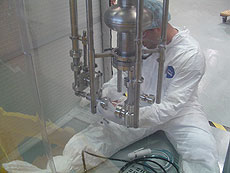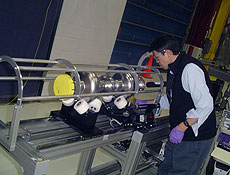| Wednesday, March 31, 2010 |
| Subscribe | Contact Fermilab Today | Archive | Classifieds |
India-Fermilab SRF collaboration project passes first testThe successful test of an Indian-made superconducting radio-frequency cavity moves Fermilab one step closer to building a next-generation accelerator, the proposed Project X. It also moves India closer to meeting its nuclear energy needs. "It is basically a win-win for both Fermilab and India," said Avinash Puntambekar, a mechanical engineer from India working with Fermilab on SRF technology. "We share the work; we share the success." The group celebrated last month when one of the first two single-cell, 1.3 GHz cavities fabricated in India successfully tested at a gradient of 21 megavolts per meter (MV/m), higher than the 19 MV/m required for Project X cavities, but below the 35 MV/m needed for next-generation linear collider cavities. The fabrication work was carried out at Raja Ramana Center for Advanced Technology, or RRCAT, and Inter University Accelerator Center, or IUAC. The processing of this cavity was carried out jointly by RRCAT, Fermilab and Argonne National Accelerator Laboratory. "For their very first cavity to reach this high of a gradient is very good. Historically the first cavities rarely go above 20 MV/m," said Genfa Wu, of Fermilab's Technical Division SRF research and development group. SRF cavities enable accelerators to increase particle beam energy levels while minimizing the use of electrical power by all but eliminating electrical resistance. The technology is so complex that only a few vendors outside of national laboratories can meet stringent research design standards. They will test the second cavity within a month. Fermilab engineers are working with Indian collaborators on addressing welding concerns on the second cavity by doing conducting an additional surface treatment called centrifugal barrel polishing. "Still, for a first attempt, cavity performance exceeded our expectation despite the non-ideal welding," Wu said. India and Fermilab have a long history of collaboration. Indian engineers and physicists from four laboratories and universities have been working with Fermilab and Argonne for the last 2 ½ years to learn the SRF trade from assembly to welding and processing to testing. With consultation from Fermilab, India is building its own cavity fabrication and test facilities. "We basically have done a technology transfer, what we call a recipe for how cavities should be fabricated," said Joe Ozelis, Fermilab area leader for the vertical cavity test facility in the Technical Division. That SRF facility in India would help supply cavities for Project X, shorten the project's R&D phase and reduce project cost. India is collaborating with Fermilab on the R&D stage of this high-intensity proton source that could make the U.S. a leader in Intensity Frontier research. A similar high-intensity proton accelerator on Indian soil would drive a thorium-based subcritical reactor and could also be used for the transmutation of radioactive waste. "It is a mutual benefit," said Shekhar Mishra, Fermilab scientist. "This is a perfect marriage between our respective programs." -- Tona Kunz |

